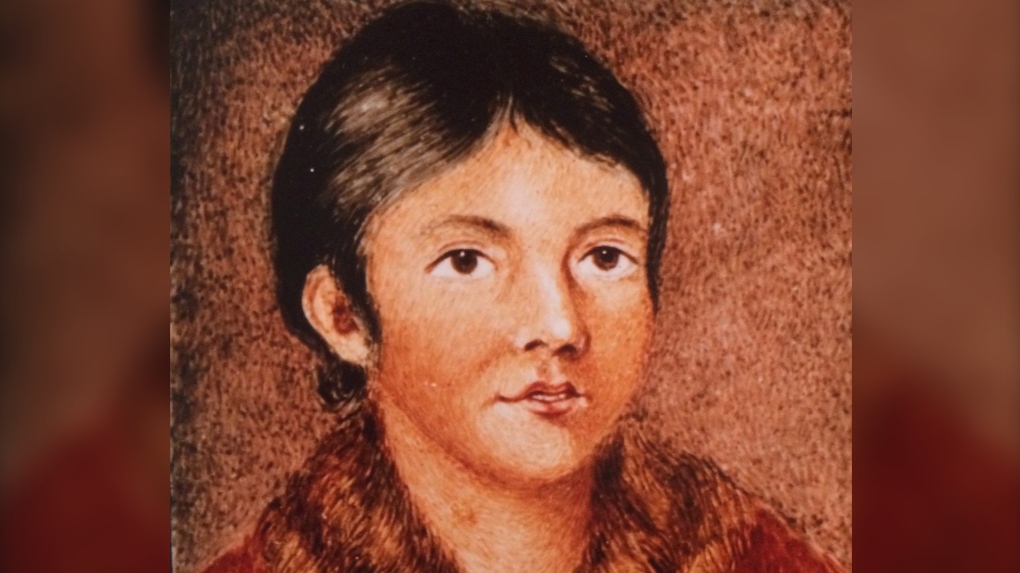Statue in Newfoundland to pay tribute to one of the last of the Beothuk people
 Mary March, also known by her Indigenous name as Demasduit, one of the last Beothuk, is shown in this painting by Lady Hamilton. A Newfoundland First Nation has announced a study of genomic links between its members and ancient Indigenous inhabitants of the island, including the disappeared Beothuk people. (THE CANADAIN PRESS/HO-Library and Archives Canada)
Mary March, also known by her Indigenous name as Demasduit, one of the last Beothuk, is shown in this painting by Lady Hamilton. A Newfoundland First Nation has announced a study of genomic links between its members and ancient Indigenous inhabitants of the island, including the disappeared Beothuk people. (THE CANADAIN PRESS/HO-Library and Archives Canada)
Plans are in the works to install a bronze statue in central Newfoundland to commemorate the death 200 years ago of Demasduit, an Indigenous woman who was among the last surviving members of the Beothuk people.
On Friday, the federal and provincial governments announced $471,000 in funding for the project in Botwood, N.L.
The larger-than-life statue will include Demasduit; her husband, Nonosabasut; and their newborn child.
In March 1819, Nonosabasut -- a Beothuk chief -- and the couple's child were killed by a group of English settlers who were on an expedition to the island's interior. Demasduit was taken prisoner and renamed Mary March.
She was later taken to an Anglican mission, where she created a list of 180 words from her language, including the word Beothuk.
There was an attempt to return her to her people, but Demasduit died aboard the British warship HMS Grasshopper while it was in the Bay of Exploits on Jan. 8, 1820.
The proposed sculpture will be placed on Botwood's Blueberry Hill, which overlooks the bay.
The statue will be surrounded by a healing garden, which the provincial government has described as "a place of quiet reflection for our shared journey towards truth and reconciliation."
The original plan for the project was to install the statue in 2020, but the COVID-19 pandemic made that impossible.
The Beothuk were wiped out after European settlers encroached on their land, resulting in deadly conflicts and the introduction of new diseases.
Demasduit's niece, Shawnadithit, is believed to be the last known Beothuk. She died of tuberculosis in St. John's in June 1829.
The province is contributing $115,000 to the Botwood project and Ottawa has committed $356,000 from the Department of Canadian Heritage. Other funding partners include the Town of Botwood, Miawpukek First Nation, Botwood Heritage Society, Botwood Mural Arts Society and the United Church of Canada.
This report by The Canadian Press was first published Nov. 4, 2022.
CTVNews.ca Top Stories

Canadian team told Trump's tariffs unavoidable right now, but solutions on the table in surprise Mar-a-Lago meeting
During a surprise dinner at Mar-a-Lago, representatives of the federal government were told U.S. tariffs from the incoming Donald Trump administration cannot be avoided in the immediate term, two government sources tell CTV News.
Pedestrian killed by Via Rail train near Kingston, Ont.
Regular rail traffic has resumed with severe delays.
Muskoka reacts to major snowfall, hundreds stuck on Highway 11
From road closures, power outages, weather declarations and nonstop shovelling, Muskoka residents were faced with nearly a metre of persistent snowfall on Saturday.
Saskatoon priest accused of sexual assault says he meant to encourage young girl with hug and kiss
A Saskatoon priest accused of sexual assault says he meant to encourage and reassure a young girl when he hugged and kissed during his testimony at Saskatoon Provincial Court Friday.
Beef prices reach record highs in Canada
The cost of beef continues to rise, reaching record highs on grocery store shelves ahead of the busiest time for many grocers and butchers before the holiday season.
Trump threatens 100% tariff on the BRIC bloc of nations if they act to undermine U.S. dollar
U.S. president-elect Donald Trump on Saturday threatened 100 per cent tariffs against a bloc of nine nations if they act to undermine the U.S. dollar.
Bob Bryar, drummer for rock band My Chemical Romance, dead at 44
Bob Bryar, former drummer for the band My Chemical Romance, has died. He was reportedly 44.
Toronto man accused of posing as surgeon, giving four women injections
A 29-year-old Toronto man has been charged after allegedly posing as a surgeon and providing cosmetic procedures on several women.
'Disappointing': Toronto speed camera cut down less than 24 hours after being reinstalled
A Toronto speed camera notorious for issuing tens of thousands of tickets to drivers has been cut down again less than 24 hours after it was reinstalled.

































